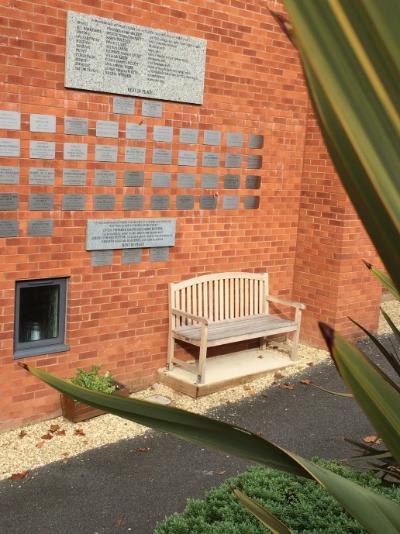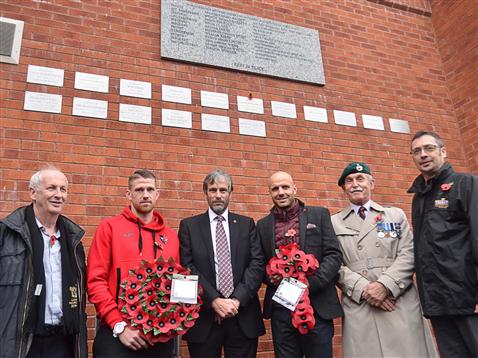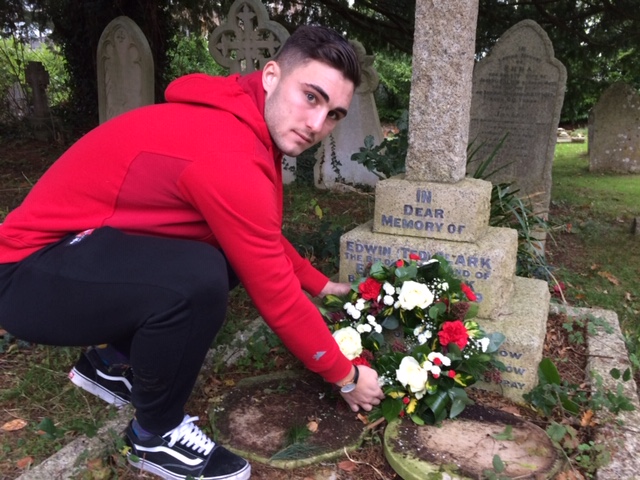Exeter City Pays Homage To Their World War Heroes
16/05/2019 - 3.00
Martin Weiler
The impact of the two World Wars on Exeter City Football Club had largely been forgotten through the mists of time. Forgotten that is until a project to mark the centenary of the club’s epic tour of South America in 1914 got underway. There is a clue in that date!
Exeter visited Argentina and Brazil and famously in the last match of the tour were the opponents in Brazil’s first ever game. Quite a claim to fame given the iconic place in football held by the five times World Cup winners.
The details of the trip are expertly covered in Aidan Hamilton’s book ‘Have you ever played Brazil? The story of Exeter City’s 1914 tour to South America’. But what became clear in the book and in separate initiatives, including an exhibition and a community play at the city’s Northcott Theatre, was that the First World War was part of the narrative.
In fact, war was declared as the team were travelling back from Brazil and indeed the ship was shot at three times on the way home; ironically all friendly fire. The fog of war!
The final chapters in the book explore the impact of the War on the Club and its players. Controversially the Southern League, like the Football League, continued for the 1914/15 season. But increasingly players signed up and the casualties started.
Amazingly none of the South American party lost their lives although there were significant injuries to some; Billy Smith lost a leg for example. However, we now know of at least 13 who had worn the City colours who died during the conflict. It needed careful research as at least one player was incorrectly reported as dead.
The question 100 years on was how to honour and remember them. The Supporters’ Trust, the owners of the club since 2003, backed a proposal to build a garden of remembrance and a memorial wall for plaques listing our war dead from WW1 and WW2.

Exeter City FC Remembrance Garden
Initial research uncovered 11 former players who had died in WW1 and a beautiful stone memorial was produced with their names, ranks and regiments.
In a moving ceremony on Remembrance Day 2014 the entire first team squad with Manager Paul Tisdale gathered to pay their respects. Captain Scott Bennett laid a wreath on behalf of the players, as did representatives of the Club and Supporters’ Trust.

Paul Tisdale and other Club representatives at the commemoration of the outbreak of the First World War
Subsequent research found two further deaths of former players and plaques have been added for them. As the centenary of each death arrives then a full tribute has been produced for the match programme, websites and social media. These have included details of any known local war memorials or graves that include the names of the Exeter City fallen.
One of the City casualties, Edwin Clark, is the only one to be buried locally and First Team Captain Jordan Moore-Taylor laid a wreath on his grave in Clyst St Mary churchyard on the exact centenary of his death in 1917 in a ship accident in Grimsby.

Jordan Moore-Taylor laying a wreath on grave of Edwin Clark
Back in 2016 the focus of remembrance had shifted to the Battle of the Somme. Four of the City 13 were killed in the carnage, including two on the very first day. These two represented the range of those affected. Fred Bailey had been a reserve player while Evelyn Lintott, who played for Exeter while training to be a teacher in the city, went on to play for England.
Working with the Royal British Legion, a ceremony was held on 1 July, the exact centenary of the first day. Representatives of organizations with links to the four deceased each laid a special Somme cross and a wreath in their memory.
To mark the centenary of the end of the war a number of other initiatives were taken. The Exeter City Supporters’ Club arranged a visit to many of the war graves of Exeter City players in Belgium and France. A wreath was placed at each one. An exhibition about the visit and the players concerned was held at the Club in November 2018.

Exeter City FC matchday programme for the 2018 Remembrance match
And even far flung graves were not forgotten. A supporter laid a wreath on the grave of Leonard Turner in Alexandria, Egypt while on a visit there. The last fatality took place in 1919 when Billy Stoneman died of flu on his way back from Palestine. Aidan Hamilton made a special trip to his grave near Lyon to pay respects on behalf of the Club on the exact centenary of his death.
So, within 5 years a remarkable amount of information had been researched and commemorations held. Truly not forgotten.
And the same goes for the Second World War. Again, very little was known and research is still uncovering names of those who lost their lives. A further stone plaque has been erected and other plaques added as new names come to light. Seven Club victims have been identified so far.
In 2017 special ceremonies were held to mark the 75th anniversary of the Exeter Blitz which claimed two City lives. Former player Albert Potter was an air raid warden and is buried in Whipton, Exeter. Jordan Moore – Taylor laid a wreath on behalf of the Club. It was a moving moment witnessed by Albert’s daughter, Pam, and grandchildren.
A wreath was also laid by Club Chairman Julian Tagg on the grave in Exmouth of one of his predecessors Captain Frederick Hunter who died while on fire watching duty.
Five years on things have also advanced generally on the heritage front. The Supporters’ Trust set up an Exeter City History Group and in partnership with the University of Exeter have successfully bid for two rounds of Heritage Lottery Fund grants. This has culminated in a new Exeter City Football Club Museum and a charity to run it. We also have a wonderful on-line resource: The Grecian Archive (www.grecianarchive.exeter.ac.uk).
The war years will continue to be given due focus. More and more facts emerge as the heritage work flourishes. There is, for example, the story of Steve Stacey, City’s first black player. Steve was the product of war as his father was a black United States serviceman based in Bristol in the 1940s. Steve was the result of a liaison with a local woman. The US authorities sent his father home and it was only late in his life that they were reunited.
The latest findings about how the two World Wars affected the Club will be revealed in a new publication by Aidan Hamilton due to be published in October 2019. The book is on the History of St James Park, Exeter’s long-term home ground and reveals how the military used the stadium during both conflicts.
We have realized that you never stop finding out new aspects of the Club’s history. If anyone has any information to add then we’d love to hear from you at historygroup@ecfc.co.uk
Biography

Brought up in London watching Hounslow Town, Brentford and Spurs, Martin studied History and Archaeology at the University of Exeter and stayed on to live and work in the Devon city. This led to following Exeter City and increasingly getting involved as the Supporters Trust became owners in 2003. Martin is a member of the Trust Board and in 2016/7 was Trust Chair and a Club Director. He is also a Trustee of the Club’s charity, the City Community Trust. Martin is Secretary of the Exeter City History Group and a Trustee of the new Exeter City Football Club Museum Trust. Martin is also particularly interested in the history of stadiums and has visited all ‘the 92’.


/prod01/wlvacuk/media/departments/digital-content-and-communications/images-2024/240624-Alumni-Awards-2024-Resized.jpg)
/prod01/wlvacuk/media/departments/digital-content-and-communications/images-18-19/220325-Engineers_teach_thumbail.jpg)
/prod01/wlvacuk/media/departments/digital-content-and-communications/images-2024/240627-UN-Speaker-Resized.jpg)
/prod01/wlvacuk/media/departments/digital-content-and-communications/images-2024/240320-Uzbekistan-Resized.jpg)
/prod01/wlvacuk/media/departments/digital-content-and-communications/images-2024/240229-The-Link-Resized.jpg)
/prod01/wlvacuk/media/departments/digital-content-and-communications/images-2024/240627-Lady-Aruna-Building-Naming-Resized.jpg)